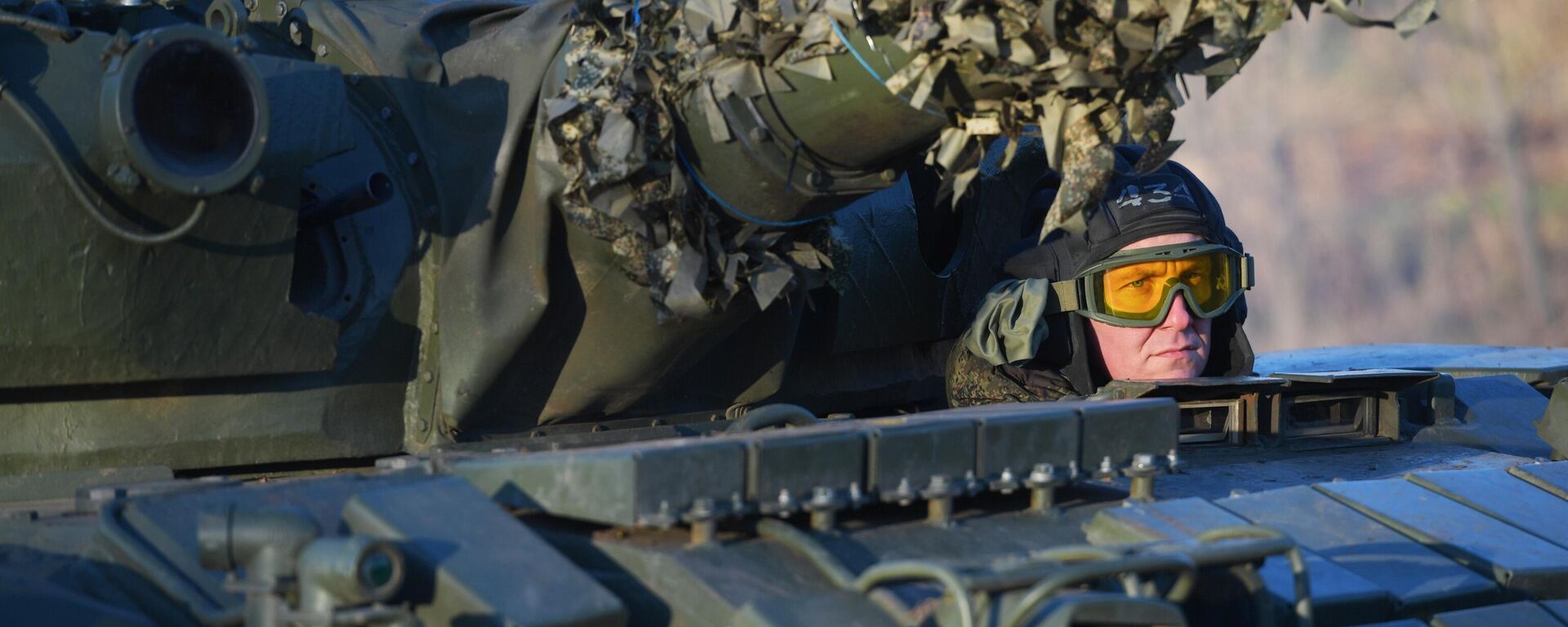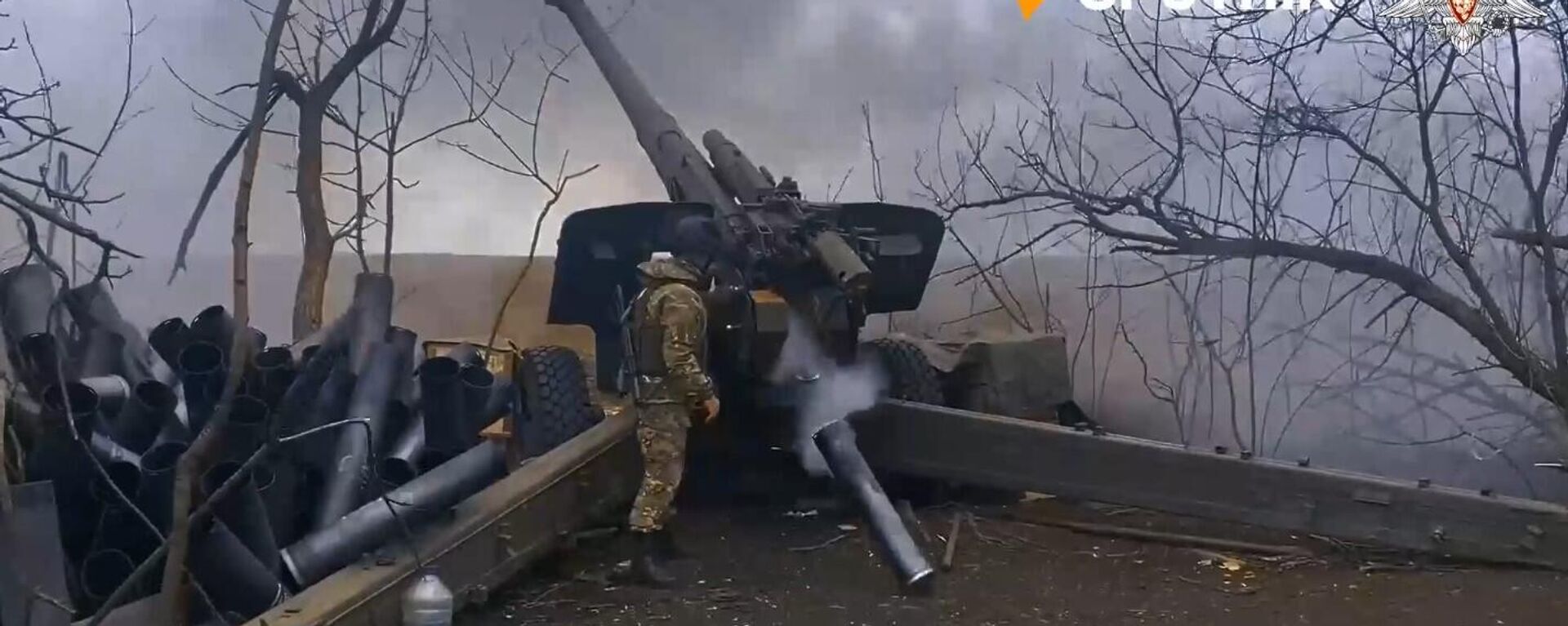https://en.sputniknews.africa/20231118/1063637519.html
Revolution in Russian Defense Industry: Innovations Sparked by Special Op in Ukraine
Revolution in Russian Defense Industry: Innovations Sparked by Special Op in Ukraine
Sputnik Africa
Real-time adjustments have been introduced to Russia's military-industrial complex during the country’s special military operation in Ukraine, which was... 18.11.2023, Sputnik Africa
2023-11-18T17:15+0100
2023-11-18T17:15+0100
2023-11-18T17:49+0100
russia's special operation in ukraine
russia
ukraine
kiev
russian ministry of defense
weapon
russian armed forces
military
international
https://cdn1.img.sputniknews.africa/img/07e7/0b/12/1063637700_0:244:3208:2048_1920x0_80_0_0_0abef5d147f80190d085873c1c723d23.jpg
A new modification of the Krasnopol laser-guided artillery weapon system is now in active service with the Russian Army in the special operations zone. As noted in the High Precision Systems holding (Vysokotochnyye Kompleksy, part of Rostec State Corp), Krasnopol was developed with front-line experience in mind. In total, hundreds of weapons have now been tested on the battlefield. Sputnik reports on some of the most important.Hitting The IlluminatorThose artillery units lucky enough to receive 152mm Krasnopol rounds now play the role of snipers. This ammunition is specially designed to destroy targets with the first shot. Such impeccable effectiveness is sometimes hard to achieve, but the cost of such ammunition is much lower compared to conventional high-explosive shells. Krasnopol has a range of 25 km. This is more than enough to counter Ukrainian M777 howitzers.The ammunition has a semi-active laser-guided warhead. It automatically aims at a point illuminated by a laser designator, typically operated by a drone or ground-based artillery observer. Aerodynamic rudders correct its trajectory.Russian gunners have been actively using the new Krasnopol-M modification since the beginning of the conflict. It is compatible with several Russian artillery systems, including the D-20, 2S3 Akatsiya, 2S19 Msta-S, 2A65 Msta-B and 2A36 Giatsint-B. Such weapons proved to be powerful and reliable, with only one drawback: poor accuracy in low cloud cover. A newer version, however, uses the GLONASS satellite navigation system (a Russian GPS alternative) instead of regular lasers, making it "bulletproof" against all weather vagaries.Guarding The SkyIn late October, the Russian Ministry of Defense reported the swift destruction of 24 Ukrainian aircraft within a mere five days, crediting this remarkable feat to a novel tactical approach. The strategy involved deploying the S-400 Triumf missile system in conjunction with the Beriev A-50 Airborne Early Warning and Control (AEW&C) aircraft.Enhancing this operation, Russian forces incorporated the use of 40H6E active homing heads, boasting a capacity to target objects within a 380 km radius. In this specific scenario, the A-50s function as the reconnaissance eyes of the air defense system. Leveraging their robust radar capabilities, these aircraft can detect targets up to 650 km away and relay this information to the command post of the anti-aircraft missile battery, enabling preparedness for launches at maximum range. In essence, the S-400s can assert air control over Kharkov from strategic locations such as Voronezh or Lipetsk.Both the A-50 aircraft and the 40H6E missile launchers have long been integral components of the Russian Army's arsenal. The question arises: why is such a display of military prowess occurring at this particular moment? It's conceivable that Russian command opted to preserve these valuable assets and avoid risking their deployment near the front line, where the air defenses of Kiev had not yet been entirely neutralized.Artillery’s Worst NightmareThe Lancet kamikaze drones, developed by the ZALA Aero Group, a part of Kalashnikov Concern, have undergone noticeable advancements during the ongoing military operation. Demonstrating efficacy against armored vehicles, artillery, and field fortifications, these barrage munitions have evolved into a formidable weapon. As of early November 2023, a compilation of approximately 750 videos showcases numerous instances of Ukrainian and Western equipment encountering setbacks. Among these, 53.9% were claimed as damaged, with 30.6% rendered completely destroyed. Artillery and mortars emerge as the primary targets from a statistical standpoint.Initially, there were only two variants of Lancet drones: the basic version with a 3 kg payload and the reduced version with a 1 kg payload. However, the continuous release of new and enhanced iterations by ZALA complicates the accurate assessment of their distinct performance characteristics.One notable improvement includes an increase in the range of the basic type from 40 to 70 km, enabling Russian drone operators to target coveted Ukrainian HIMARS systems effectively. Additionally, a noteworthy innovation in Lancet's capabilities is their ability to function en masse, operating under the "drone swarm" concept.New ‘Old’ BombsIn the initial months of the conflict, the Russian Air Force faced limitations as it was not yet fully operational. Presumably, the Russian command hesitated to risk their expensive equipment while Kiev's air defenses remained intact.A pivotal shift occurred with the introduction of the Unified Planning and Correction Module (UMPC) by NPO Bazalt, a prominent Russian weapons manufacturing company. The UMPC, conceived in the early 2000s, has now become a widespread implementation.Functionally equivalent to the US-developed Joint Direct Attack Munition (JDAM), the UMPC serves as a guidance kit transforming unguided ("dumb") bombs into precision-guided munitions. Much like the JDAM, which employs GPS/GLONASS coordinates, the UMPC enables bombs to glide and strike targets up to 80 km away from the discharge point. Consequently, bombers could penetrate deep into Ukrainian territory without entering zones covered by Ukraine's air defenses.The Russian Air Space deploys UMPCs in conjunction with FAB-500 500kg air-dropped bombs. FAB-500s surpass other projectiles in lethality and are comparable to the formidable Iskander-M ballistic missiles.These munitions have demonstrated their efficacy in dismantling Ukrainian fortifications. Furthermore, experts have observed the use of FAB-1500 bombs on the front, boasting a more limited range than FAB-500s but delivering a formidable ton and a half of explosives—an influential factor, especially considering the abundance of free-falling bombs in Russian Army warehouses awaiting deployment.
https://en.sputniknews.africa/20231114/russia-india-discussing-joint-production-of-aircraft-weapons-1063536165.html
https://en.sputniknews.africa/20231113/demand-for-russian-arms-not-decreasing-despite-sanctions-remains-at-50-55bln--moscow-1063523410.html
https://en.sputniknews.africa/20231112/1063493470.html
russia
ukraine
kiev
Sputnik Africa
feedback@sputniknews.com
+74956456601
MIA „Rossiya Segodnya“
2023
News
en_EN
Sputnik Africa
feedback@sputniknews.com
+74956456601
MIA „Rossiya Segodnya“
Sputnik Africa
feedback@sputniknews.com
+74956456601
MIA „Rossiya Segodnya“
russia, ukraine, kiev, russian ministry of defense, weapon, russian armed forces, military, international
russia, ukraine, kiev, russian ministry of defense, weapon, russian armed forces, military, international
Revolution in Russian Defense Industry: Innovations Sparked by Special Op in Ukraine
17:15 18.11.2023 (Updated: 17:49 18.11.2023) Real-time adjustments have been introduced to Russia's military-industrial complex during the country’s special military operation in Ukraine, which was launched in February 2022.
A new modification of the Krasnopol laser-guided artillery weapon system is now in active service with the Russian Army in the special operations zone. As noted in the High Precision Systems holding (Vysokotochnyye Kompleksy, part of Rostec State Corp), Krasnopol was developed with front-line experience in mind. In total, hundreds of weapons have now been tested on the battlefield. Sputnik reports on some of the most important.
Those artillery units lucky enough to receive
152mm Krasnopol rounds now play the role of snipers. This
ammunition is specially designed to destroy targets with the first shot. Such impeccable effectiveness is sometimes hard to achieve, but the cost of such ammunition is much lower compared to conventional high-explosive shells. Krasnopol has a range of 25 km. This is more than enough to counter Ukrainian M777 howitzers.
The ammunition has a semi-active laser-guided warhead. It automatically aims at a point illuminated by a laser designator, typically operated by a drone or ground-based artillery observer. Aerodynamic rudders correct its trajectory.
Russian gunners have been actively using the new
Krasnopol-M modification since the beginning of
the conflict. It is compatible with several Russian artillery systems, including the D-20, 2S3 Akatsiya, 2S19 Msta-S, 2A65 Msta-B and 2A36 Giatsint-B. Such weapons proved to be powerful and reliable, with only one drawback: poor accuracy in low cloud cover. A newer version, however, uses the GLONASS satellite navigation system (a Russian GPS alternative) instead of regular lasers, making it "bulletproof" against all weather vagaries.
In late October, the Russian Ministry of Defense reported the
swift destruction of 24 Ukrainian aircraft within a mere five days, crediting this remarkable feat to a novel tactical approach. The strategy involved deploying the S-400 Triumf missile system in conjunction with the
Beriev A-50 Airborne Early Warning and Control (AEW&C) aircraft.
Enhancing this operation, Russian forces incorporated the use of 40H6E active homing heads, boasting a capacity to target objects within a 380 km radius. In this specific scenario, the A-50s function as the reconnaissance eyes of the air defense system. Leveraging their robust radar capabilities, these aircraft can detect targets up to 650 km away and relay this information to the command post of the anti-aircraft missile battery, enabling preparedness for launches at maximum range. In essence, the S-400s can assert air control over Kharkov from strategic locations such as Voronezh or Lipetsk.
Both the A-50 aircraft and the 40H6E
missile launchers have long been integral components of the Russian Army's arsenal. The question arises: why is such a display of military prowess occurring at this particular moment? It's conceivable that Russian command opted to preserve these valuable assets and avoid risking their deployment near the front line, where the air defenses of Kiev had not yet been entirely neutralized.
Artillery’s Worst Nightmare
The Lancet kamikaze drones, developed by the ZALA Aero Group, a part of Kalashnikov Concern, have undergone noticeable advancements during the ongoing military operation. Demonstrating efficacy against armored vehicles, artillery, and field fortifications, these barrage munitions have evolved into a formidable weapon. As of early November 2023, a compilation of approximately 750 videos showcases numerous instances of Ukrainian and
Western equipment encountering setbacks. Among these, 53.9% were claimed as damaged, with 30.6% rendered completely destroyed. Artillery and mortars emerge as the primary targets from a statistical standpoint.
Initially, there were only two variants of Lancet drones: the basic version with a 3 kg payload and the reduced version with a 1 kg payload. However, the continuous release of new and enhanced iterations by ZALA complicates the accurate assessment of their
distinct performance characteristics.
One notable improvement includes an increase in the range of the basic type from 40 to 70 km, enabling Russian drone operators to target coveted Ukrainian HIMARS systems effectively. Additionally, a noteworthy innovation in Lancet's capabilities is their ability to function en masse, operating under the "drone swarm" concept.
In the initial months of the conflict, the Russian Air Force faced limitations as it was not yet fully operational. Presumably, the Russian command hesitated to risk their expensive equipment while Kiev's air defenses remained intact.
A pivotal shift occurred with the introduction of the
Unified Planning and Correction Module (UMPC) by NPO Bazalt, a prominent
Russian weapons manufacturing company. The UMPC, conceived in the early 2000s, has now become a widespread implementation.
Functionally equivalent to the US-developed Joint Direct Attack Munition (JDAM), the UMPC serves as a guidance kit transforming unguided ("dumb") bombs into precision-guided munitions. Much like the JDAM, which employs GPS/GLONASS coordinates, the UMPC enables bombs to glide and
strike targets up to 80 km away from the discharge point. Consequently, bombers could penetrate deep into Ukrainian territory without entering zones covered by Ukraine's air defenses.
The Russian Air Space deploys UMPCs in conjunction with FAB-500 500kg air-dropped bombs. FAB-500s surpass other projectiles in lethality and are comparable to the formidable Iskander-M ballistic missiles.
These munitions have demonstrated their efficacy in dismantling Ukrainian fortifications. Furthermore, experts have observed the use of
FAB-1500 bombs on the front, boasting a more limited range than FAB-500s but delivering a formidable ton and a half of explosives—an
influential factor, especially considering the abundance of free-falling bombs in Russian Army warehouses awaiting deployment.





